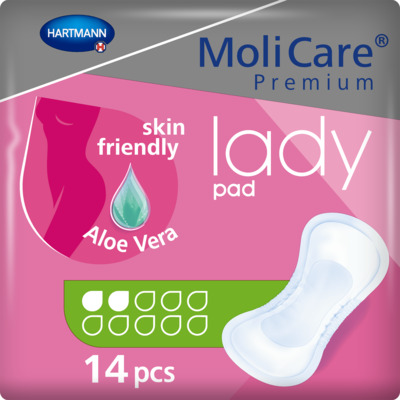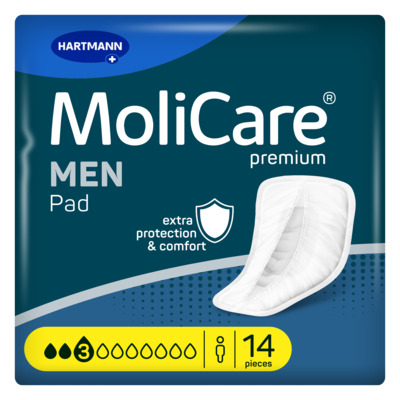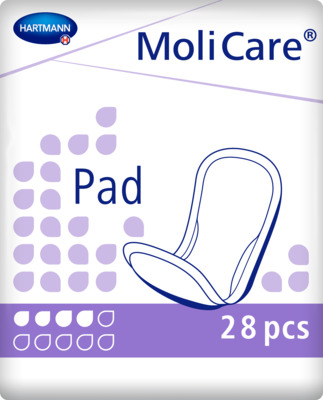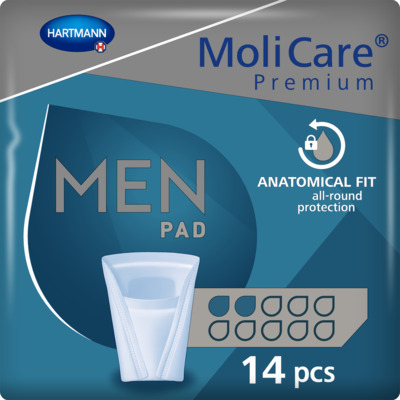Incontinence Advice
Urinary Incontinence: Causes and Treatment Options
Urinary incontinence, a condition marked by the loss of bladder control, affects millions globally. Its impact varies, from the occasional discomfort of urine leakage when coughing, to the urge for using the toilet immediately. Many may question how many times a day to wee, in this instance.
This condition isn’t always a normal part of ageing, but if you do experience it, you should not be embarrassed about it. In fact, we are happy to lift the taboo surrounding incontinence, and in this article, we will help you to recognise urinary incontinence, including its causes, symptoms, and how you can improve your lifestyle around it, as well as the medical conditions to consider, and what treatment options are available, such as our pants for incontinence.

Urinary Incontinence Symptoms:
Recognising these symptoms is the first step towards addressing the condition and improving your quality of life. The types of urinary incontinence and their symptoms vary, each presenting unique challenges:
Stress Incontinence: This type occurs when activities like coughing, sneezing, laughing, or exercise put pressure on your bladder, leading to unexpected urine leakage. It's a common issue that many encounter, particularly during physical exertion or moments of forceful laughter.
Urge Incontinence: Characterised by a sudden and intense need to urinate, this type often leads to involuntary urine loss before you can reach a bathroom. Frequent nighttime urination (nocturnal enuresis) can also be a symptom. While sometimes caused by minor conditions like infections, urge incontinence can also signal more serious concerns, including neurological disorders or diabetes.
Overflow Incontinence: This is when you experience continuous or intermittent dribbling, indicative of a bladder that isn't emptying completely. This type of incontinence often leaves you feeling as though you haven’t completely emptied your bladder, leading to frequent, small amounts of urine loss.
Functional Incontinence: This occurs when physical or mental impairments prevent timely bathroom access. An example is functional incontinence is severe arthritis, which might slow down the process of undressing, resulting in accidents.
Mixed Incontinence: A combination of more than one type of incontinence, most commonly stress and urge incontinence. This combination can complicate diagnosis and treatment, as it involves multiple underlying causes.
Total Incontinence: This results from congenital bladder abnormalities from birth, which can result in spinal cord injuries that will affect communication between the brain and the bladder, as well as bladder fistula development.
Medicines That Can Cause Incontinence
Certain medicines can affect the passage of urine, often leading to an increased need to urinate. Medications that may provoke this are: angiotensin converting enzyme (ACE) inhibitors, diuretics, various antidepressants, hormone replacement therapy (HRT), and sedatives.
When to Consult a Healthcare Professional
While discussing urinary incontinence can be uncomfortable, consulting a healthcare provider is crucial, especially if the condition frequently impacts your daily life or social interactions. It's important to recognise that urinary incontinence may:
-
Cause you to limit your activities or avoid social gatherings.
-
Negatively affect your overall quality of life.
-
Increase the risk of falls, particularly in older adults, due to the urgency and frequency of bathroom visits.
-
Indicate a more serious underlying health issue.
Understanding these symptoms and types of urinary incontinence is pivotal in seeking appropriate urinary incontinence treatment and advice. Early consultation with a healthcare provider can lead to effective management strategies, ensuring that urinary incontinence does not dictate the terms of your daily life.
You can learn more about How Anxiety Affects Your Bladder and Bowel
Urinary Incontinence Causes
Many factors can contribute towards different causes of urinary incontinence. Here is what to consider to receive the correct treatment and management:
Temporary Causes of Urinary Incontinence:
Diet: Certain foods and drinks can temporarily exacerbate urinary incontinence. Alcohol, caffeine, carbonated drinks, and foods high in spice, sugar, or acid (like citrus fruits) can irritate the bladder. Even some medications and supplements, like heart and blood pressure drugs, sedatives, muscle relaxants, and high doses of vitamin C, act as diuretics, stimulating your bladder. Be sure to follow our guidance regarding the right bladder-friendly drinks, as well as foods and drinks that irritate the bladder to improve your diet.
Urinary Tract Infections (UTIs): These can irritate your bladder, leading to strong urges to urinate and potential incontinence. We also our tips on how to control and prevent cystitis, as well as the fastest way to get rid of a bladder infection.
Constipation: The proximity of the rectum to the bladder means hard stool can press against the bladder, causing overactivity and increased urinary frequency. Using our deluxe incontinence skin care products such as MoliCare Skin Barrier Cream can help in preventing skin irritation.
Persistent Causes of Urinary Incontinence:
Pregnancy and Childbirth: Hormonal changes and the weight of the foetus can cause stress incontinence. Childbirth, especially vaginal delivery, can weaken bladder control muscles, damage nerves, and lead to pelvic floor prolapse, contributing to incontinence.
Ageing: The bladder's capacity to store urine can decrease with age, and involuntary bladder contractions may increase.
Menopause: Post-menopause, there's a reduction in oestrogen, which can deteriorate the tissues of the bladder and urethra. Find ways to manage incontinence during menopause now.
Prostate Issues in Men: Conditions like an enlarged prostate (benign prostatic hyperplasia) and prostate cancer, as well as their treatments, can lead to incontinence after prostate cancer and other prostate problems.
Obstructions in the Urinary Tract: Tumours or urinary stones in the urinary tract can obstruct normal urine flow, leading to overflow incontinence.
Neurological Disorders: Disorders like multiple sclerosis, Parkinson's disease, stroke, brain tumours, or spinal injuries can disrupt nerve signals vital for bladder control, resulting in incontinence.
Read more about Incontinence During And After Pregnancy

Risk Factors for Urinary Incontinence
Several factors can heighten the likelihood of developing urinary incontinence, including:
-
Gender: Women often experience stress incontinence due to factors like pregnancy, childbirth, menopause, and female anatomy. Men with prostate gland issues are more prone to urge and overflow incontinence.
-
Age: Aging can weaken the muscles in the bladder and urethra, diminishing bladder capacity and leading to more frequent involuntary urine release.
-
Impact of Excess Weight: Carrying extra weight can exert additional pressure on the bladder and its supporting muscles, resulting in leakage during activities like coughing or sneezing.
-
Smoking and Incontinence: Tobacco use is linked to an increased risk of urinary incontinence.
-
Family History: A family history of urinary incontinence, particularly urge incontinence, can elevate your risk of developing the condition.
-
Underlying Health Conditions: Certain diseases, such as neurological disorders or diabetes, can contribute to an increased risk of urinary incontinence.
Understanding these risk factors is key to identifying and managing urinary incontinence effectively. If you fall into one or more of these categories, it's advisable to discuss them with your healthcare provider.
How To Diagnose Urinary Incontinence
Diagnosing urinary incontinence typically begins with a discussion about your medical history and bladder control issues. Your healthcare provider may ask about the frequency of urination, instances of urine leakage, the amount of leakage, and the duration of incontinence. This information helps identify patterns indicating a specific type of incontinence, not just urinary incontinence. It's crucial to mention all medications and any history of pregnancies and childbirth, as these can impact incontinence.
Diagnostic tests may include:
-
Physical Exam: Checks for physical causes of incontinence, including a pelvic exam for women or prostate examination for men.
-
Urine Samples (Urinalysis): Tests for infections or blood in urine.
-
Bladder Ultrasound: A painless imaging test using sound waves to view the bladder's content and its emptying ability.
-
Stress Test: Involves coughing or engaging in physical activities to observe urine leakage.
-
Cystoscopy: A procedure using a camera-equipped tube to examine the interior of the urinary tract.
-
Urodynamic Testing: Assesses bladder capacity and the functioning of the urethral sphincter muscle, often involving fluid insertion into the bladder.
-
Pad Test: Involves wearing a special pad to measure urine loss.
Additionally, keeping a journal at home to record urinary habits, leakage occurrences, and related activities can be beneficial. This record provides valuable insights for your provider, aiding in a more accurate diagnosis. Be sure to bring this journal to your appointment for discussion.
Psychotherapy: The well being of the mind can also be a determining factor
All of us are familiar with that urgent need to go to the toilet when we are overstimulated (e.g. before an exam). The mind can affect incontinence: nervousness, stress or anxiety, for example, can trigger urinary incontinence problems.
In addition, there is the enormous psychological stress that afflicts those affected and greatly impacts their emotional well-being7. The psychological stresses that result from incontinence themselves encourage the development of bladder weakness problems. Psychotherapy approaches or relaxation techniques can help to disrupt this vicious cycle8.
Which treatment options and opportunities are specifically established for a typical case of irritable bladder, for example, can only be determined during an initial consultation with a specialist psychologist.

Preventing Urinary Incontinence:
Here are the recommended ways to decrease the risk of urinary incontinence. Remember, prevention of urinary incontinence is impossible, but early recognition can ease later effects:
Keep your weight within a healthy range.
Engage in pelvic floor strengthening exercises.
Steer clear of substances that irritate the bladder, like caffeine, alcohol, and acidic foods.
Increase your fibre intake to avert constipation, a known contributor to urinary incontinence.
Refrain from smoking or seek assistance to stop if you currently smoke.
What Are Pelvic Floor Exercises?
Kegel exercises, advisable for urinary incontinence treatment, offer a straightforward method to strengthen your pelvic floor muscles. These exercises are vital in managing various types of urinary incontinence, especially stress and sudden urinary incontinence.
To perform Kegel exercises, you need to lift, hold, and then relax your pelvic floor muscles. A practical way to identify these muscles is by attempting to halt urine flow mid-stream while urinating, but this should only be a temporary measure to locate the muscles, as regularly stopping urine flow isn't advisable.
For optimal results, aim to complete three sets of these exercises, with each set consisting of 10 repetitions, twice daily. This routine can significantly contribute to alleviating symptoms associated with what is urinary incontinence, helping to regain control over bladder function.
Continence Products to Treat Urinary Incontinence
No matter what form of urinary incontinence that you may have, it is worthwhile investing in continence products, which will help you to manage your everyday tasks with little complications, and are very discrete and will fit seamlessly with different body types. As such, these include:
- Pull up pants, perfect for those who wish to partake in sports with incontinence.
- Continence bed protection, essential for those who experience bed wetting.
FAQs
Why do older people become incontinent?
Older people often experience incontinence due to natural ageing processes, which can weaken the bladder muscles and reduce bladder capacity. Additionally, age-related health issues like menopause in women, prostate problems in men, and chronic conditions such as diabetes or neurological disorders contribute to incontinence.
How do you fix urinary incontinence?
Treating urinary incontinence depends on its type and cause. Common approaches include lifestyle changes (like fluid and diet management), pelvic floor exercises, medications, and in some cases, surgery. For specific treatment, it's essential to consult a healthcare provider for a personalised plan.
How do you stop urine leakage in old age?
To manage urine leakage in old age, one can practise pelvic floor exercises (like Kegels), make lifestyle adjustments (such as reducing caffeine and alcohol intake, and maintaining a healthy weight), and use continence products. Consulting a healthcare professional for tailored advice is also recommended.
What is the cause of urinary incontinence?
Urge urinary incontinence is often caused by bladder overactivity, which can stem from urinary tract infections, bladder irritants, neurological disorders (like multiple sclerosis or stroke), or diabetes. It is characterised by a sudden, intense urge to urinate and difficulty controlling urine flow.
Sources
- London Urology Specialists, (2021). Vesico-Vaginal Fistula. [online] Available at: https://www.londonurologyspecialists.co.uk/vesico-vaginal-fistula/ [accessed 26/01/24]

MoliCare® Premium Lady Pad 2 Drops
<h2>Skin Friendly Pant Liners</h2> <p>For women that experience slight incontinence and bladder weakness, across different age groups, it can be a challenge to find the right bladder weakness product that is easy to apply and wear without the worry of potential leakages. Fortunately, we understand this approach, hence why we are happy to offer our MoliCare® Premium Lady Pad 2 drops, that is skin-friendly, Aloe Vera applied, and comes with 14 liners per bag.</p> <h2>Slim and discreet liners</h2> <p>Whether dealing with stress incontinence or urge incontinence, these panty liners offer a discreet and easy solution on the go. Simply place the pad in your underwear and secure it with the adhesive strip for all-round protection. Available in different absorbency levels, MoliCare® bladder weakness products cater to all levels of bladder weakness, ensuring secure care.</p> <h2>Control Bladder Weakness</h2> <p>Enjoy the benefits of these body-shaped absorbent panty liners, designed for women with bladder weakness. The pads offer discreet, reliable protection with features including odour control and fast absorption.</p> <p>With a wide adhesive strip, you can comfortably fix the pad in your regular underwear, providing secure and comfortable fixation. The pads are skin-friendly, featuring soft, breathable materials, including foam cuffs, and a top sheet treated with Aloe Vera.</p> <p>Keeping your skin healthy is a priority, which is why MoliCare® Premium Lady Pads have a skin-neutral pH value of 5.5 and an antibacterial finish. They are also dermatologically tested, offering peace of mind.</p> <h2>Buy pant liners online</h2> <p>Never worry about running out with our convenient order service and fast delivery direct to your door. Enjoy free shipping on orders over £50.</p> <p>If you need assistance, our professional customer service team is here to support you in choosing the right product. Reach out to us today at 0800 028 9470 and experience the comfort and reliability of MoliCare® Premium Lady Pads.</p>
MoliCare® Premium Men Pad 3 Drops (ISO 441ml)
<p><strong>Reliable and discreet incontinence pads for men with an instant-dry feeling</strong></p> <p>Bladder weakness is difficult to live with, the last thing you want to worry about is incontinence protection. That’s why our best-ever MoliCare® premium MEN Pad 3 drops offer an <strong>all-round protection</strong> that keeps everything dry and comfortably in place while fitting discreetly in your regular underwear.</p> <p>The incontinence pad for men quickly <strong>removes urine from the surface up to 86 %* faster than before</strong> and neutralises unpleasant odours to leave you feeling instantly dry and in control thanks to the new <strong>MoliCare SkinGuard</strong>®<strong> Absorbent Core Technology</strong>. This skin-friendly technology not only helps you feel up to 90 %* drier than previous MoliCare® premium<strong> </strong>MEN pads, it also helps to maintain healthy skin and preventing irritation.</p> <p><strong>Engineered for the male anatomy</strong> and dermatologically tested for maximum skin compatibility, these male urinary pads do not contain colour, perfume or latex making them environmentally friendly too.</p> <p>*Compared to last generation</p>
MoliCare® Pad 4 Drops
<h2>Handy MoliCare incontinence pads to carry on the go</h2> <p>Our MoliCare® Pad 4 Drops are an essential product for those experiencing slight incontinence, allowing you to regain control and live your busy and active life without the interference of bladder weakness. Designed for both men and women, this incontinence pad for men and women offers exceptional dryness and protection, ensuring your comfort and confidence.</p> <h2>‘Barely There’ Reassurance and Reliability</h2> <p>The MoliCare® Pad 4 Drops are slimline, discreet, and adjusted to fit your body seamlessly. It fixes securely inside your underwear, providing a ‘barely there’ comfort feel. With its soft and skin-kind fabric, along with a wide adhesive fixing strip on the backsheet, you can go about your day with the assurance of being protected against leakages.</p> <p>The absorbent core effectively prevents your skin from becoming too moist, while the elastic anti-leak edging adds an extra layer of security and peace of mind. Say goodbye to any worries about odours, as the MoliCare® Pad 4 Drops also neutralises odours to keep you fresh and confident throughout the day. Don't let incontinence hold you back from living life to the fullest.</p> <p>Ordering your MoliCare® Pad 4 Drops is hassle-free, as we offer fast delivery direct to your door. With our price match promise, you can trust that you're getting the best value for your money. Plus, enjoy free delivery on all orders over £50.</p> <p>If you need assistance in finding the perfect incontinence product for your needs, our friendly customer care team is here to help. Don't hesitate to reach out to us at 0800 028 9470. Take control of your life with the reliable protection and comfort of the MoliCare® Pad, alongside other <a href="https://www.hartmanndirect.co.uk/incontinence-products/incontinence-pads" style="color:#0563c1; text-decoration:underline">incontinence pads</a>.</p>
